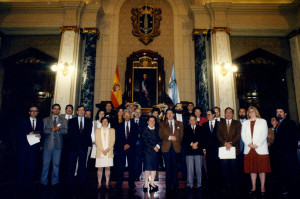LNP and HST
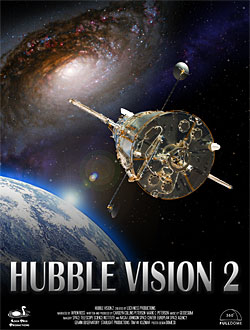 Here at Loch Ness Productions, we have a soft spot in our hearts for the Hubble Space Telescope. It dates back to when I was a graduate student and working on an HST instrument team. I wrote about that experience in my personal blog as a sort of remembrance for the telescope’s 25th anniversary celebrations. There are many of us who were involved in some way with the telescope telling our stories this week about our experiences with the telescope.
Here at Loch Ness Productions, we have a soft spot in our hearts for the Hubble Space Telescope. It dates back to when I was a graduate student and working on an HST instrument team. I wrote about that experience in my personal blog as a sort of remembrance for the telescope’s 25th anniversary celebrations. There are many of us who were involved in some way with the telescope telling our stories this week about our experiences with the telescope.
Over the years, HST has made more than a million observations and provided some of the most iconic space images ever. We’ve followed along, and used many photogenic results in three popular astronomy shows.
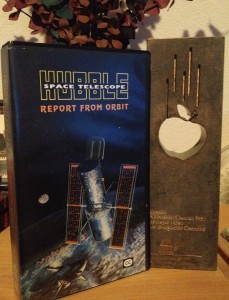 We started with Hubble: Report From Orbit, produced in 1990 originally as a slide-tape planetarium show package. Later, we made a conventional video based on the original show materials.
We started with Hubble: Report From Orbit, produced in 1990 originally as a slide-tape planetarium show package. Later, we made a conventional video based on the original show materials.
As a lark, we sent a copy of the video to a contest that regularly reviewed and made awards for the best in science outreach programming and content. To our great surprise and satisfaction, the show won the Grand Prize, including the heavy and impressive Bronze Prism statuette you see here.
One of the most unique experiences of my life connected to Hubble was to travel to Spain for the award ceremony, held in La Coruña. My guide and host, physicist Dr. Alberto Baez (father of singer Joan Baez), and his wife, Joan Bridge Baez, escorted me to the ceremonies and helped translate my acceptance speech. The awards presentation was attended by local politicians, science journalists, and producers from around the world, many of whom wanted to know everything I could tell them about the Hubble Space Telescope and the science it was doing.
Hubble Vision
As science results continued to come in, we created a new show in 1994, called Hubble Vision (same name as the book I wrote). Ten years later, we followed it with HUBBLE Vision 2. It was our last show in classic (slide-based) form, and our first in fulldome.
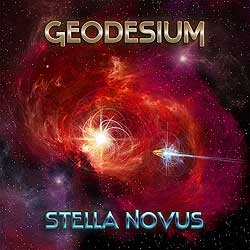 Our fascination with HST didn’t stop with the shows. Mark found particular inspiration in the gorgeous images from the telescope, and he created some of his best-known space music for the shows. The music from Hubble Vision 2 is encapsulated on Geodesium Stella Novus. We always thought of it as the music Hubble would give us if it could sing about the wonders it has observed. Mark also made a fulldome and flat-screen music video for one of the tracks, Light Echoes, using artfully choreographed HST images.
Our fascination with HST didn’t stop with the shows. Mark found particular inspiration in the gorgeous images from the telescope, and he created some of his best-known space music for the shows. The music from Hubble Vision 2 is encapsulated on Geodesium Stella Novus. We always thought of it as the music Hubble would give us if it could sing about the wonders it has observed. Mark also made a fulldome and flat-screen music video for one of the tracks, Light Echoes, using artfully choreographed HST images.
For us, personally and professionally, Hubble Space Telescope has been a point of pride because it informed our well-received shows (and Hubble Vision 2 is still popular). These presentations have allowed us to share the excitement and beauty of HST images and data with planetarium audiences around the world. That counts for a lot.
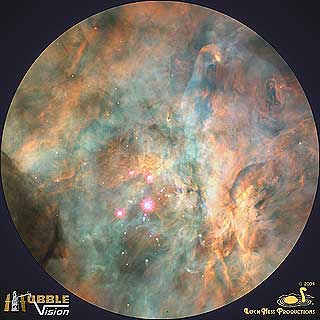 People LOVE space images, and they like being kept “in the loop” when wonderful discoveries are being made. For all of us who spend our lives communicating astronomy, Hubble’s science is an incredible gift that keeps on giving! And, I know how exciting it is for the scientists who get to use this wonderful observatory.
People LOVE space images, and they like being kept “in the loop” when wonderful discoveries are being made. For all of us who spend our lives communicating astronomy, Hubble’s science is an incredible gift that keeps on giving! And, I know how exciting it is for the scientists who get to use this wonderful observatory.
We congratulate the thousands of people around the world who have made the Hubble Space Telescope work, use it for science, and strive to share its science with the world. We’re pleased to be part of the outreach community that teaches about astronomy, creates shows, and writes books and articles, all using Hubble results.
It’s been a great 25 years. Hubble has shown us the true visions of the cosmos. We look forward to even more and better images and data for a long time to come!

